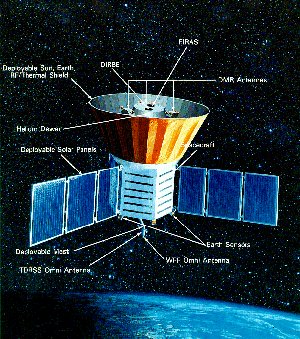 |
|
Fig. 1:
John Mather (left) and George Smoot (right).
|
 |
 |
|
Fig. 2:
The COBE satellite in orbit outside the Earth's
atmosphere. The entrance horn for FIRAS and DMR experiments
are labelled.
|
|  |
COBE was launched in 1989 and mapped the Cosmic Microwave Background
(the CMB) over whole sky during the 4-year period 1989-1993. The CMB,
the residual heat left over from the Big Bang itself, was discovered
by Arno Penzias and Robert Wilson in 1964, a feat for which they were
awarded the 1978 Nobel Prize in Physics. In its first 9 minutes of
operation John Mather's instrument, the Far Infrared Astronomical
Spectrometer, showed that the intensity of the CMB as a function of
wavelength (its spectrum) follows exactly the theoretical prediction
of Max Planck (in 1900) for the spectrum of a perfect black-body, an
object in perfect thermodynamical equilibrium with its radiation
field. The full 4 years of COBE/FIRAS data confirmed the conclusion
from the first 9 minutes: any deviation from an exact black-body curve
is extremely small, less than about one part in 10,000. This requires
the early universe to be almost uniform. A global equilibrium between
matter and radiation as precise as that observed could not have been
established later than about 1 month after the Big Bang itself.
George Smoot's instrument, the Differential Microwave Radiometer, was
designed to map small variations in the temperature of the CMB about
its mean value of 2.73 degrees above absolute zero. After one year of
operation Smoot and his colleagues were able to demonstrate for the
first time that such variations exist at a level of about one part in
one hundred thousand. Their presence had been predicted by Russian
and American theorists more than 20 years before COBE was launched.
They can be thought of as reflecting weak variations in the density of
matter and radiation in the early Universe. Since the time at which
we now observe them (about 400,000 years after the Big Bang) they have
grown through the action of gravity to turn into all the structures we
see around us today. COBE's DMR thus gave us the first real picture of
what the Universe looked like before there were any stars or galaxies.
The COBE experiment took more than 15 years to design, construct and
complete and it required the effective collaboration of about 1000
scientists and engineers. Tight groups of scientists worked together
intensely under the leadership of John Mather and George Smoot to
interpret the data from FIRAS and from DMR. In addition, John Mather
acted as Lead Scientist for the COBE project as a whole, coordinating
the entire enterprise. Scientific advances of the kind recognised by
this year's Nobel Prize require major effort from large numbers of
extremely talented and dedicated individuals.
It is interesting that in the 15 years since COBE, no subsequent
experiment has been able to improve upon FIRAS's spectrum measurement.
Further information of fundamental importance should be hidden in the
details of the CMB spectrum, but technical advances to date have not
yet brought them within reach. On the other hand, there have been
great efforts to improve on DMR's measurements of structure in the
microwave background, and technical advances here have led to further
spectacular results, most notably from NASA's WMAP satellite launched
in 2001. It appears that structure in the early universe has precisely
the statistical properties expected if all structure originated as
quantum fluctuations of the vacuum itself during a very early period
of accelerated "inflationary" expansion. In addition, these new data
confirm that the current contents of the Universe are dominated by as
yet unidentified forms of Dark Matter and Dark Energy. The next major
advance is expected to come from the European Space Agency's Planck
satellite, for which launch is exected in 2008. As the principal
German partner within the Planck project, the Max Planck Institute
for Astrophysics will be heavily involved in the interpretation of
these new data.
Simon White
|